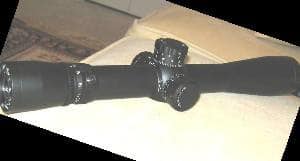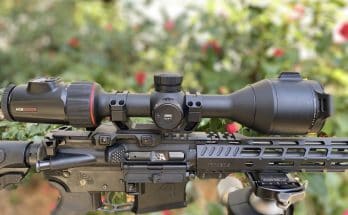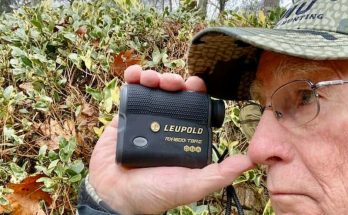Leupold has Incorporated the best features of the Mark 4 Tactical scopes and VX-III scopes to come up with the Leupold Mark 4 3.5-10x40mm LR/T M3. It has the versatile 3×10 power range, 30mm tube, side focus, M3 style windage and elevation system with Bullet Drop Compensator dials, crystal clear Multicoat 4 coated, indexed matched lenses, and that great tactical look.
Leupold has made so many upgrades to their scopes and model changes in the past couple of years, it is hard to keep up with all the great scopes and features available. Features like adding click windage adjustments to the VXII line, 30 mm tubes with side focus on the VXIII line, special Boone & Crockett and Varmint Hunter ranging reticles, finger adjustable windage and elevation on the VXIII line, fast focus ocular lens adjustments and more. Visit www.leupold.com for more details.
Now more about the new Leupold Mark 4 3.5-10x40mm LR/T M3. When you see this scope, the first thing you notice are the tactical style side focus, windage and elevation adjustment knobs. You will know right off the bat that this is not “Grandpa’s Old Weaver.” The focus knob on the left side replaces the old adjustable objective (AO) to focus the scope at different ranges. I have used scopes with AO’s on most of my rifles for years, mostly for target and varmint hunting. The drawback of an AO is that it is almost impossible to use from the shooting position. The side focus takes care of that problem. If your target is a little fuzzy, just reach up and turn the focus while looking through the scope. Definitely a plus.

On the windage and elevation turrets, you will see a large diameter elevation knob with two rows of numbers. The bottom row of numbers counts the ‘clicks” of elevation. The top row is a scale of numbers calibrated to certain calibers to compensate for bullet drop. The scope comes with four of these calibrated Bullet Drop Compensator (BDC) caps, each with a slightly different BDC scale, and can be easily changed to match the caliber of rifle used. The M3 knobs move the crosshairs 1 MOA or approximately one inch at 100 yards with each click. The one inch clicks resulted form the Army’s request to have adjustments that could reach to 1000 yards with one turn of the knob for Army snipers. It is faster and easier to keep track of than 1/4” clicks most scopes have. A scope with 1/4” clicks requires four full turns of the knob for 1000 yards of elevation.
If you think you need 1/4” clicks, there is an identical scope with M1 knobs for more precise adjustments. The one inch clicks were a concern for me until I used it at the range. Now I wish all my scopes had M3 one inch adjustments. Look at the photo and we will see how the Bullet Drop Compensator works. You will see that when you dial in 5 clicks of elevation, you will see the number 3 above the 5 for 300 yards. So if you are zeroed at 100 yards it takes 5 clicks of elevation for a 300 yard target, it takes about 10 clicks for a 400 yard shot and so on. The pictured dial is calibrated for .308 Winchester 168 grain Match ammo. Check the top of the knob and you will see it printed on top of the cap. This dial is used for this caliber or any other caliber with a similar trajectory. The scope comes with four caps that are easy to change using the provided Allen wrench.
(Sorry, but some of the photos were deleted)
The other three BDC’s are marked for the .223 Remington, the 30’06, and the 300 Winchester Magnum. You can also loosen the caps and reset them to zero after you zero your rifle. Those four different BDC’s cover most standard calibers. Just match your caliber to one of the BDC’s. For example, shooting 150 grain boat tails in my .308 requires the 30’06 BDC. My .280 Remington and .270 Winchester are very close to the 300 Winchester Mag BDC. If none of the BDC’s match your rifle, a little work with a computer and range testing will tell you how many clicks it takes for any distance and you can just dial in the range with using the bottom row scale. The windage adjustment is marked in 1/2” clicks because it only takes a few clicks to dial in a lot of windage. Two clicks would give you four inches of windage at 400 yards. Four clicks would give you 8 inches at that same distance. My initial testing was done from 250 yards , but the BDC’s seem to be very close. I will be able to test on a 600 yard range pretty soon and I can hardly wait.
I was able to make it to GUNSITE HILLS range in Lexington, GA for a great time testing the Leupold out to 650 yards. The scope was better than I expected. I installed the 30’06 BDC that turned out to be right on all the way out to 650 yards. The targets were 24”x24” white steel plates with 2” red bullseyes out to 300 yards and 4” bullseyes for the longer targets.
I started with the 200 yard target and adjusted winage a little then started shooting the targets in order. This was the first time I have shot on a range at such a long distance, but it turned out to be a blast. The M3 dials made it easy to dial in the range quicky and make an accurate shot. The M3 BDC was right on the mark all the way out. After about 30 rounds of shooting and getting comfortable with rifle, scope and range, I managed to make my last 3 shots count. I put the last two shots in the bull at 600 then clicked up 2MOA for the 650 target and hit the red bull the first shot. That was it for the day. I was not about to shoot another shot that day. The scope was perfect in every way. What I really noticed was that even at those extended ranges, the target and crosshairs were as one image. It was extremely easy to make incredible shots. I am sold on this Mark 4 M3. Now if I can just get my deer stand moved back a few hundred yards……..
One thing is missing that I thought should have been carried over from the VXIII. Select VXIII scopes have a built-in range estimator. It’s a simple system that uses the Duplex reticle and two sets of numbers on the power selector ring. The numbers facing front show the scope’s magnifications. The numbers facing back show distances in yards and meters. Looking through the scope, the space between the tip of the thicker post and the center of the reticle covers 16″ at 200 yards, when set at low power. So let’s say you’re targeting a deer whose body is 16″ backbone to brisket. Adjust the power selector so that the deer’s body fits between the center of the crosshair and the top of the lower heavy post. Then, read the approximate distance in yards, from a minimum of 200 at low power to a maximum of 600 at high power.
I guess Leupold didn’t expect too many deer hunters to use this scope. Most hunters now carry a laser range finder, but for those who don’t, the scope can be had with a Mil Dot reticle for range estimation.
Of course this scope performed up to Leupold standards. Crystal clear with all the bells and whistles working perfectly. It would be hard to beat this scope for long range target work or hunting. If you want one it will set you back about $1150.
See our Remington LTR rifle review with this scope.



